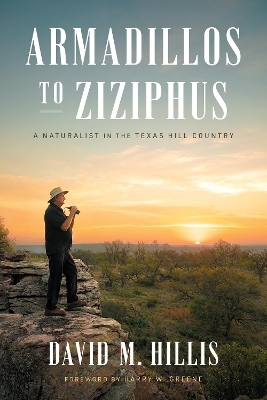
Armadillos to Ziziphus
University of Texas Press (Verlag)
978-1-4773-2673-2 (ISBN)
For most of five decades, evolutionary biologist David Hillis has studied the biodiversity of the Texas Hill Country. Since the 1990s, he has worked to restore the natural beauty and diversity of his Mason County ranch, the Double Helix. In his excursions around his ranch and across the Edwards Plateau, Hillis came to realize how little most people know about the plants and animals around them or their importance to our everyday lives. He began thinking about how natural history is connected to our enjoyment of life, especially in a place as beautiful and beloved as the Hill Country, which, not coincidentally, happens to be one of the most biodiverse parts of Texas.
Featuring short nontechnical essays accompanied by vivid color photos, Armadillos to Ziziphus is a charming and casual introduction to the environment of the region. Whether walking the pasture with his Longhorn cattle, explaining the ecological significance of microscopic organisms in springtime mud puddles, or marveling at the local Ziziphus (aka Lotebush, a spiny shrub), Hillis guides first-time visitors and long-term residents alike in an appreciation for the Hill Country’s natural beauty and diversity.
David M. Hillis is the director of the Biodiversity Center at the University of Texas at Austin’s College of Natural Sciences. He was awarded a MacArthur Fellowship in 1999 and was elected to the US National Academy of Sciences in 2008. He is also known for his discovery of numerous new species, including Austin’s iconic Barton Springs Salamander. Harry W. Greene is a professor of ecology and evolutionary biology at Cornell University and the author of Tracks and Shadows: Field Biology as Art, among other books.
Foreword by Harry W. Greene
Preface
I. The Texas Hill Country: A Naturalist’s Paradise
1. Geological Setting of the Edwards Plateau
2. From Acid Sands to Alkaline Clays
3. Hill Country Weather: Droughts, Floods, and Severe Storms
4. Some Texas Icons Haven’t Been Here All That Long
5. Hill Country Endemics
6. What Is the Value of Biodiversity?
II. The Seasonal Life of a Vernal Pool
7. Tilting at Tiny Windmills
8. Crustacean Wonders
9. The Fascinating Flora of Vernal Pools
10. Those Who Live in Glass Houses
11. A Season of Symphonies
12. What Happened to All Our Frogs?
III. Flowing Waters: Aquifers, Caves, Springs, and Rivers
13. Life without Light
14. Lanterns of Summer
15. Musings about Mussels
16. The Last Wild River
IV. Life of a Grassland
17. Why Do Some Grasses Grow in the Winter, but Others in the Summer?
18. Butterflies, Hummingbirds, and Other Pollinators
19. The Noble Life of a Dung-Roller
20. Where Have All the Quail Gone?
21. Grasshoppers, Locusts, and Plagues
22. The History of Texas Cattle Written in Their DNA
V. In the Woodlands and Brushlands
23. Containing and Preventing Oak Wilt
24. The Challenges of Being an Oak Tree in the Hill Country
25. How Do Trees Sense When It Is Time to Leaf Out and Bloom?
26. The Dr. Jekyll and Mr. Hyde of Trees
27. Spring Is Here, and So Are the Snakes
28. Songs of the Summer Dog Days
29. Going Batty
30. Deer Densities on the Edwards Plateau
31. Bucks in Velvet
32. The Future of Hill Country Deer Populations
33. The Carbon Cycle and How It Affects Our Daily Lives
VI. Backyard Biology
34. The Remarkable Life of Hummingbirds
35. Ways to Attract and Increase Bird Populations
36. The Unexpected Beauty and Diversity of Lichens
37. There Is More to Mistletoe than Kissing
38. The Ups and Downs of Ants
39. A Pattern in the Web
40. Caterpillar Plagues and Their Connection to the Weather
41. Predators and Second Chances
VII. Climatic Adaptations
42. Toadally Cool
43. The Surprising Life Cycle of a Monarch Butterfly
44. How Do Animals Survive the Winter? Part 1: Migrating
45. How Do Animals Survive the Winter? Part 2: Keeping Warm and Active
46. How Do Animals (and Plants) Survive the Winter? Part 3: Waiting Out the Cold
VIII. Restoration and the Future of the Hill Country’s Natural Resources
47. The Restoration and Benefits of Native Grasses
48. The Pros and Cons of Brush Control
49. Recovery of a Texas Icon: The Texas Horned Lizard
50. Avoiding the Dangers of Lead Poisoning in Game Meat
51. Our Climate Future in Central Texas
52. If the Earth Is Warming, Why Did We Just Have a Record Cold Snap?
53. Practical, Painless, and Significant Solutions to Climate Change
54. Six Resolutions for Supporting Native Plants and Animals
Index
| Erscheinungsdatum | 16.02.2023 |
|---|---|
| Vorwort | Harry W. Greene |
| Zusatzinfo | 77 color illus. |
| Verlagsort | Austin, TX |
| Sprache | englisch |
| Maße | 152 x 229 mm |
| Gewicht | 934 g |
| Themenwelt | Sachbuch/Ratgeber ► Natur / Technik ► Natur / Ökologie |
| Naturwissenschaften ► Biologie ► Ökologie / Naturschutz | |
| ISBN-10 | 1-4773-2673-1 / 1477326731 |
| ISBN-13 | 978-1-4773-2673-2 / 9781477326732 |
| Zustand | Neuware |
| Haben Sie eine Frage zum Produkt? |
aus dem Bereich


